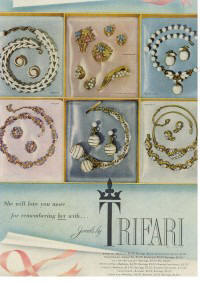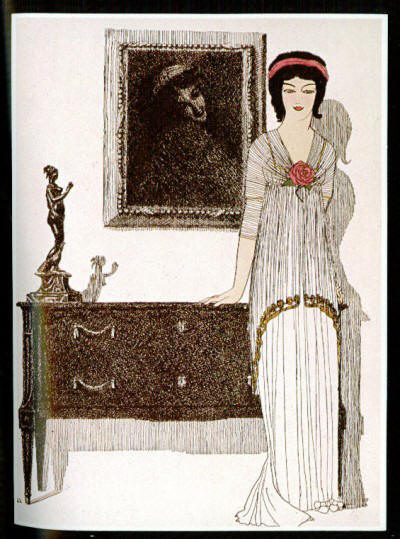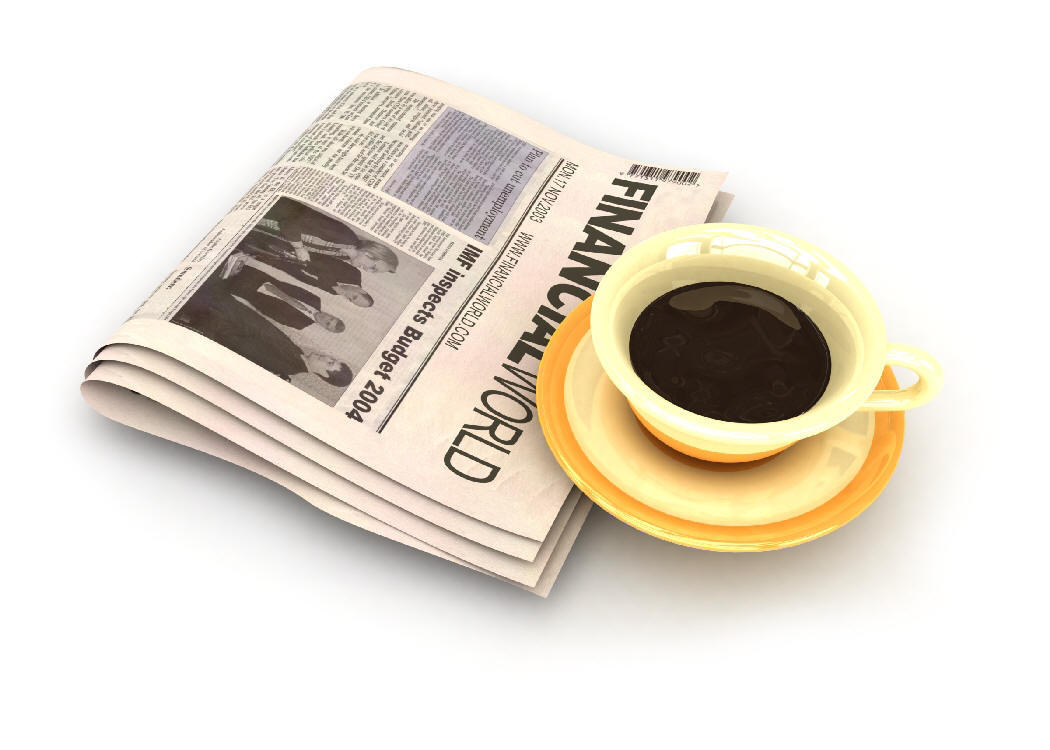Vintage Antique Costume Jewelry and More for Less!
Signed Vintage Costume Jewelry
Unsigned Vintage Costume Jewelry
Contemporary Pre- owned Costume Jewelry
Wedding, Prom and Party Jewelry
Collectables and Commemoratives
Designer Galleries
Trifari
Weiss
Kramer
Coro, Corocraft &
Vendome
Lisner
Napier
Monet
Park Lane
Avon
Sarah Coventry
Marvella
JJ
Art
Alice Caviness
Hobe'
Miriam Haskell
Florenza
Eisenberg
Hattie Carnegie
Beaujewels
D&E, Juliana and
Juliana Style
Robert
Hollycraft
Bogoff
Krementz
Schiaparelli
Warner
Boucher
Harry Iskin
Kenneth Jay Lane, KJL,
Kenneth Lane
Mazer Brothers & Jomaz
Little Nemo
Austria
Accessocraft N.Y.C.
Robert DeMario
Pell
Ciner
Nettie Rosenstein
Matisse and Renoir
Miracle
Bergere
Erwin Pearl
Beaucraft
Carl Art
Laguna
Gerry's
Brooks
Karu Arke
Whiting & Davis
BSK
Joan Rivers
Musi
Givenchy
Les Bernard
Schreiner
Judy Lee
Sandor
Barclay
Cadoro
Christian Dior
Mylu
Mimi di N
Regency
Jewelarama
Danecraft
Pauline Rader
Sherman
Schrager
Carolee
Eugene
Beatrix
1928
Stanley Hagler, Mark
Mercy & Ian St. Gielar
Joseff of Hollywood
Michal Negrin
Theodor Fahrner
Spratling
Unger Brothers
Rebajes
Gerard Yosca
Los Castillo
Cini
Star-Art
Coppola e Toppo
Walter Lampl
Los Ballesteros
Castlecliff
Elzac
Swoboda
David
Andersen
Fred A. Block
Déja/Réja
Chanel
Silson
B. David
HAR
Pennino
Ben Amun
William Kerr
Kirks Folly
Esther Lewittes
CIRO
Aksel Holmsen
Jakob Bengel
Auguste Bonaz
Van Dell
ORB [Otto R. Bade]
N.E. From
Graziella Laffi
Freirich
Husár D
Mary Frances
LIA
DeRosa
DeNicola
Stephen Dweck
Sam Kramer
Louis Rousselet Catherine Popesco
Sigi
Pineda
Josef Morton
McClelland
Barclay
Lunch at the Ritz
Larry Vrba
Agatha Paris
Leo Glass
Claudette
Charel
Monies
Staret
Hans Hansen
Engle Brothers
Ed Wiener
Korda
Adele Simpson
Louis Féraud
Panetta
Joseph Wiesner
Lea Stein
Reinad
Thelma Deutsch
Maricela [Isidro
Garcia Pina]
Garne
Robert Mandle
Antonio Pineda
Butler and Wilson
Nolan Miller
Suzanne Bjontegard
Scaasi
Zoe Coste
Henry Steig
DeLillo
Diamonbar
Capri
Cathe
Attruia
PAM
Selro & Selini
ORA
Jeray
Urie Mandle
Nina Ricci
Yves Saint Laurent,
YSL
Anna Greta Eker
Lapponia
Carl Ove Frydenburg,
COF
Rachel Gera
Am Lee
Oscar de la Renta
Calvaire
Carol Dauplaise
Richelieu
Denbe
Henkel and Grosse
Allan Adler
Vogue
Judith Jack
Parco
Tone Vigeland
R.J. Graziano
Swarovski
Tortolani
L. Razza
Emmons
Michal Golan
Dalsheim
Celebrity
ORNO
Du Jay
Banana Bob
Rousseau
Jolie Gabor
Stuart Nye
Kay Denning
Ultra Craft
Paul Lobel
Longcraft
Karl Lagerfeld
Jorgen Jensen
Deauville
Cacharel
Norma
Ann Vien
Leru
Hedy
Edgar Berebi
Scholtz and
Lammel
Jeanne
Norma Jean
Bob Mackie
Guy Laroche
Dorothy Bauer
Christopher
Radko
Tancer II
Christian
Lacroix
Elizabeth Taylor
Mark Edge
Roman
Laurel Burch
Lanvin
Flying Colors
Mizpah
Virgil Cantini
Ed Levin
Lilly Dache
Dodds
Limoges
langani
Perli
Bill Schiffer
Duane
Pastelli
Botticelli
Triad
Tara
Jewels by
Julio
Amy Lacombe
Escada
Irena Bryner, Irena
Brynner
Marlene
Margot de Taxco
Caroline
Gleik Rosene
Judith Leiber
Hess-Appel
[Jolle]
Phyllis Jacobs
Rebecca Collins
11 W. 30th
Street
AJC
Continental
James Arpad
Goldette
Bellini
Jay Strongwater
Erickson
Beamon
Vera Wang
Gale
Thomas L. Mott, TLM
Star
Gret Barkin
Kenneth Begay
Pakula
Kultaseppa Salovaara
Gucci
Marcin Zaremski
Art Smith
Rozen
Sten & Laine
David Mandel [The Show Must Go On]
Halbe
Sweet Romance
Edlee
Mary DeMarco
Robert Gardner
St. Labre
Robyn Rush
Cony/Victoria
Chico's
D'orlan, Dorlan
Elsa Freund
Mamselle
de Passille- Sylvestre
Donald Stannard
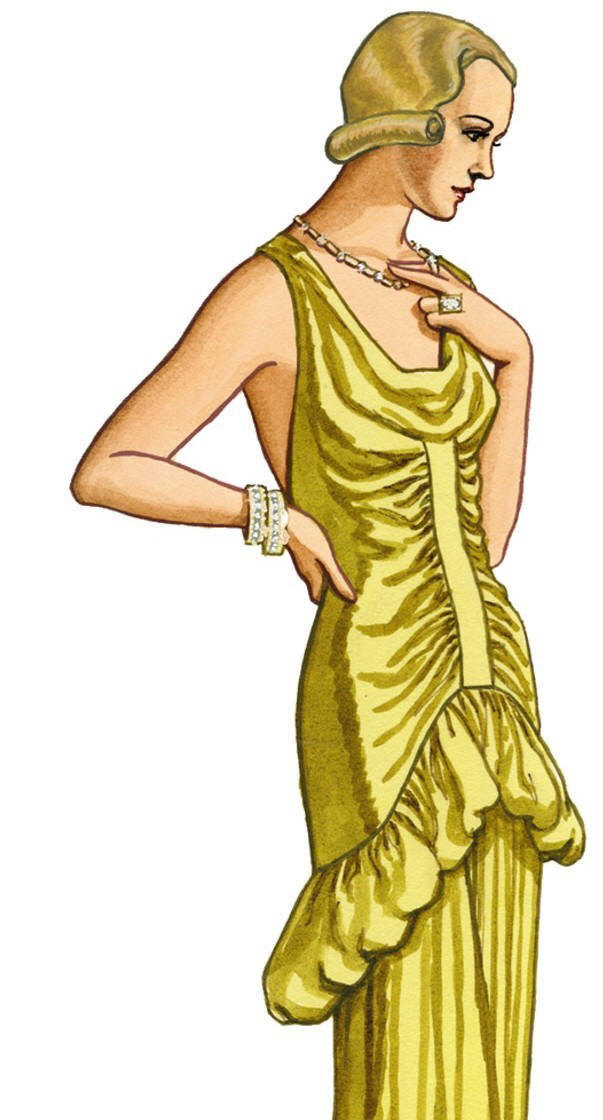
About Costume Jewelry
|
A Brief History of Costume Jewelry Costume jewelry has certainly come a long way from the Georgian times when it was made for and worn by the kings and queens only to foil robbers! I often wonder what the makers of that day would think about the collectable jewelry market of today. Who could have imagined that a throw-away item would now be desirable and even costly in some cases. So what exactly is costume jewelry? Well as you might have guessed, the market for expensive looking jewelry sort of created itself. Throughout history women wanted to look beautiful even with limited resources and they wanted what they saw the the rich wearing. Most working women could not afford jewelry made out of precious stones and gold nor could they shop in the boutiques of Haskell and her peers for higher end costume jewelry. Jewelry made out of rhinestones and other inexpensive materials fit the bill. They could afford to buy an inexpensive piece of jewelry to jazz up an outfit knowing that they could buy another when they were ready. As I referred to above, not all costume jewelry was inexpensive and gemstones were often used. During WWII, when base metals were needed for the war effort, sterling silver and metal plated with silver, gold and rhodium were used to create some of the most sought after vintage jewelry today. Costume jewelry reflects history and fashion trends. Fashion and jewelry are very closely associated and jewelry design movements sometimes grow out of social or political events. During and after WWI woman's clothing styles changed dramatically as did the type of jewelry and accessories they wore. Silhouettes changed, the bustle disappeared in favor of a sleeker look. During the Art Nouveau period, artists tired of designs with so many flourishes opted for a simpler line. During the depression, jewelry made out of colorful plastic (Bakelite) and Art Deco rhinestones were in vogue for example. During this same period Coco Chanel started completing her outfits (costumes) with paste jewelry. I do not think that Chanel created the term, however I am sure she and her contemporaries such as Elsa Schiaparelli and Hattie Carnegie popularized the term. During WWII many designers had to use sterling silver as the base metal for their creations. The United States government needed most other metals for the war effort. A thin layer of gold was often applied over the sterling. Vermeil or gold- wash, as it is sometimes called, was a finishing method used by many. Rhinestones were harder to find and you will see many wood pieces made during these years. Plastic pin backs were used instead of metal as seen on the Miriam Haskell brooches and clips of the 1940 war years. After the war, costume jewelry began more widely accepted, produced and consumed. It was not until 1954 when the federal government passed the copyright law to protect designs that this form of jewelry was taken seriously however. After all, it wasn't' REAL jewelry, no precious stones! In 1962 the hallmark required law passed.
What is vintage jewelry? Ask several people and you will probably get different answers. At Amazing Adornments we think of an item as being vintage if it was manufactured prior to the 1980s. See below Dating Jewelry by Definition. Check out our vintage jewelry patent chart for help in identifying when your jewelry find was manufactured. It has jewelry patents from 1836 to 1980. Below are American and European jewelry timelines. These timelines are meant to be a brief history . Several of the periods overlap. History of American Costume Jewelry
History of European Jewelry
Transitional Periods: Short periods of time where styles overlapped as one era moved into the next one.
These categories are not etched in stone [pun intended] they overlap and different people will use them differently.
Questions? We are more than happy to try and help! Customer Support Visit our Blog Post questions, read site news and more! |
Amazing Adornments
Cambridge, MA 02141
USA
Ph: 617.710.3042
Fax: 617.492.0634
carolyn@amazingadornments.com
webmaster@amazingadornments.com
http://www.amazingadornments.com
©2004- 2014-All rights reserved


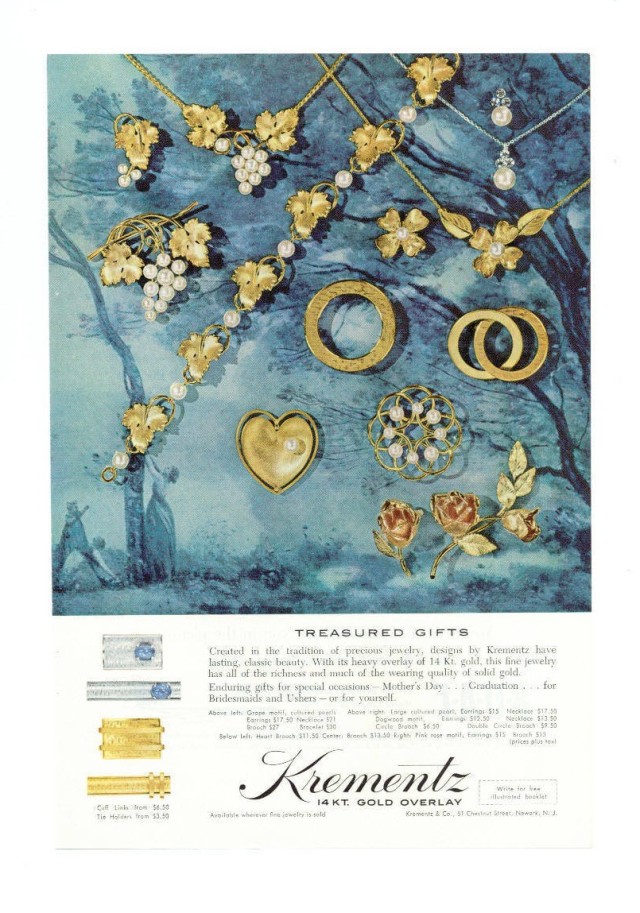 Vintage Krementz Ad From My Collection
Vintage Krementz Ad From My Collection
